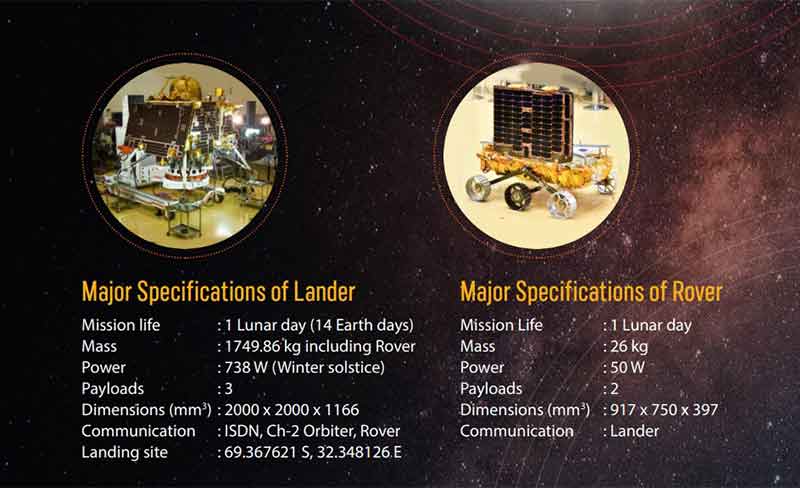- India
- Jul 14
What are the major modules of Chandrayaan-3?
• Indian Space Research Organisation (ISRO) successfully launched its third moon mission Chandrayaan-3 on July 14.
• The Launch Vehicle Mark 3 (LVM3) rocket (formerly GSLVMkIII) soared off from the second launch pad of the Satish Dhawan Space Centre in Sriharikota at 2.35 pm.
• LVM3 is the operational heavy lift launch vehicle of ISRO and is often referred to as the “Baahubali” of rockets. It has completed six consecutive successful missions. This is the fourth operational flight of LVM3.
• After the lift-off, Chandrayaan-3 got separated from the rocket and it would orbit the earth for about 5-6 times in an elliptical cycle with 170 km closest and 36,500 km farthest from Earth moving towards the lunar orbit.
• Through the Chandrayaan-3 mission, scientists are aiming at mastering the technology of soft-landing on the surface of the Moon.
• The Lander is expected to soft-land on the surface of the Moon on August 23 or 24.
• A successful mission would mean India becomes only the fourth country to accomplish the challenge, after the United States, China and the former Soviet Union.
India’s lunar exploration missions
• Chandrayaan-1, India’s first mission to the Moon, was launched successfully on October 22, 2008 from Sriharikota to orbit the Moon. It played a crucial role in the discovery of water molecules on the Moon.
• Chandrayaan-2 mission was India’s first attempt to land on the lunar surface. It was launched on July 22, 2019. On September 7, Chandrayaan-2’s Vikram lander lost its contact with ISRO as it was only 2.1 km away from its designated landing spot on the Moon’s South Pole region. The lander Vikram made a hard landing on the lunar surface.
• Chandrayaan-3 is a follow-on mission to Chandrayaan-2 to demonstrate end-to-end capability in safe landing and roving on the lunar surface.
• The Moon’s South Pole region has been chosen for the exploration because the Lunar South Pole remains much larger than that at the North Pole. There could be a possibility of presence of water in permanently shadowed areas around it.
Major modules of Chandrayaan-3
• Chandrayaan-3 consists of a Propulsion Module, Lander Module, and a Rover with an objective of developing and demonstrating new technologies required for interplanetary missions.
• The main function of the Propulsion Module is to carry the Lander Module from launch vehicle injection orbit to till Lander separation.
• The Propulsion Module will carry the Lander and Rover from injection orbit to till 100 km lunar orbit.
• It also carries a Spectro-polarimetry of Habitable Planetary Earth (SHAPE) payload to study the spectral and polarimetric measurements of Earth from the lunar orbit.
• The Lander payload will be responsible for the safe landing. Landing on the Moon’s South Pole is a challenging task owing to the uneven lunar terrain.
• The Lander will have the capability to soft-land at a specified lunar site and deploy the Rover.
• The Rover, after the soft-landing, would come out of the Lander module and study the surface of the Moon through its payloads to derive the chemical composition and infer mineralogical composition to further enhance understanding of the lunar surface.
• Rover, which has a mission life of one Lunar Day (14 Earth Days) also has another payload to determine the elemental composition of lunar soil and rocks around the lunar landing site.
• The Lander and Rover have scientific payloads to carry out experiments on the lunar surface.
Lander payloads:
i) Radio Anatomy of Moon Bound Hypersensitive ionosphere and Atmosphere (RAMBHA) - To measure the near surface plasma (ions and electrons) density and its changes with time.
ii) Chandra’s Surface Thermo physical Experiment (ChaSTE) - To carry out the measurements of thermal properties of lunar surface near polar region.
iii) Instrument for Lunar Seismic Activity (ILSA) - To measure seismicity around the landing site and delineating the structure of the lunar crust and mantle.
iv) Laser Retroreflector Array (LRA) - It is a passive experiment to understand the dynamics of Moon system.
Rover payloads:
i) LASER Induced Breakdown Spectroscope (LIBS) - Qualitative and quantitative elemental analysis to derive the chemical composition and infer mineralogical composition to further our understanding of lunar surface.
ii) Alpha Particle X-Ray Spectrometer (APXS) - To determine the elemental composition (Mg, Al, Si, K, Ca,Ti, Fe) of lunar soil and rocks around the lunar landing site.
Manorama Yearbook app is now available on Google Play Store and iOS App Store



